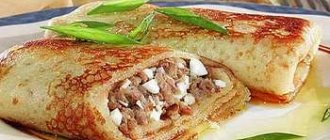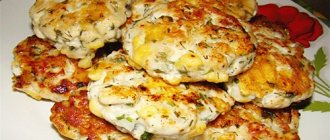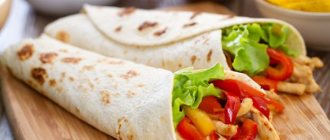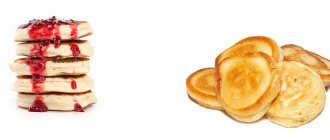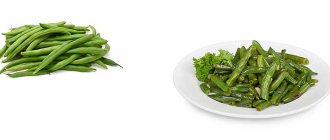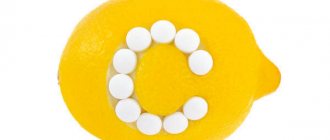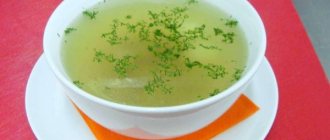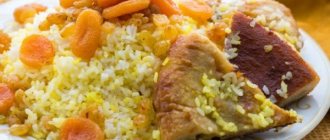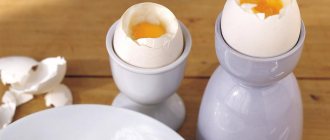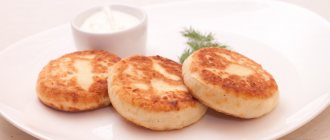Boiled beans (100g) – burn calories
| Property | Meaning |
| Calorie content, kcal | 127 |
| Proteins, g | 8,67 |
| Carbohydrates, g | 22,8 |
| Fats, gr | 0,5 |
Red Beans (with Salt, Boiled) contain the following elements: SFA - Saturated fatty acids, MUFA - Monounsaturated fatty acids, PUFA - Polyunsaturated fatty acids, Sodium, Potassium.
Boiled red beans (Kidney) contain 22.8 g of carbohydrates per 100 g of product, which is approximately 69% of the total energy from a serving or 91 kcal. Calorie content - 127 kcal. Ingredients of boiled red kidney beans:
fats - 0.50 g, proteins - 8.67 g, carbohydrates - 22.80 g, water - 66.94 g, ash - 1.09 g.
Total sugar content - 0.3 g, fiber - 6.4 g, starch - n/a.
Cholesterol content - 0.0 mg, trans fats - 0.0 g.
Composition and nutritional value
Beans are very healthy due to their chemical composition. It contains a lot of protein - up to 20 g (per 100 g), which is why it is called “vegetable meat”. Protein is absorbed by the body by 80%. The product provides energy to the body due to its carbohydrate content - up to 58%.
The presence of fiber (up to 12.4%) will allow you to feel full for a long time. The vegetable contains very little fat - up to 2%. Beans are rich in nutrients. In particular, it contains vitamins PP, E, group B (B1, B2, B9). The composition also includes many microelements.
Nutritionists recommend eating this vegetable at least 2 times a week. Due to its low calorie content, it should be included in the diet of those who want to lose weight. The product gives the body energy and many useful substances. It has low calorie content, so it does not contribute to obesity.
Vitamins
Of the fat-soluble vitamins, boiled red Kidney beans contain E and K. Of the water-soluble vitamins, there are vitamins C, B1, B2, B3 (PP), B4, B5, B6 and B9.
>»> >»> >»> >»> >»> >»> >»> >»> >»> >»> >»> >»> >»> >»> >»> >»> >»>
| Vitamins, content | Share of daily value per 100 g | |
| Vitamin A | 0.0 µg | 0,0% |
| Beta carotene | 0.0 µg | 0,0% |
| Alpha carotene | 0.0 µg | 0,0% |
| Vitamin D | 0.0 µg | 0,0% |
| Vitamin D2 | n/a | 0,0% |
| Vitamin D3 | n/a | 0,0% |
| Vitamin E | 0.0 mg | 0,2% |
| Vitamin K | 8.4 mcg | 7,0% |
| Vitamin C | 1.2 mg | 1,3% |
| Vitamin B1 | 0.2 mg | 13,3% |
| Vitamin B2 | 0.1 mg | 4,5% |
| Vitamin B3 | 0.6 mg | 3,6% |
| Vitamin B4 | 30.5 mg | 6,1% |
| Vitamin B5 | 0.2 mg | 4,4% |
| Vitamin B6 | 0.1 mg | 9,2% |
| Vitamin B9 | 130.0 mcg | 32,5% |
| Vitamin B12 | 0.0 µg | 0,0% |
Mineral composition
The ratio of mineral substances (macro- and microelements) contained in boiled red Kidney beans is presented in the table using diagrams.
>»> >»> >»> >»> >»> >»> >»> >»> >»> >»> >»>
| Minerals, content | Share of daily value per 100 g | |
| Calcium | 35.0 mg | 3,5% |
| Iron | 2.2 mg | 22,2% |
| Magnesium | 42.0 mg | 10,5% |
| Phosphorus | 138.0 mg | 19,7% |
| Potassium | 405.0 mg | 8,6% |
| Sodium | 1.0 mg | 0,1% |
| Zinc | 1.0 mg | 9,1% |
| Copper | 0.2 mg | 24,0% |
| Manganese | 0.4 mg | 18,7% |
| Selenium | 1.1 mcg | 2,0% |
| Fluorine | n/a | 0,0% |
Ingredients Boiled red beans
Nutritional value and chemical composition of “Boiled red beans”.
| Nutrient | Quantity | Norm** | % of the norm in 100 g | % of the norm in 100 kcal | 100% normal |
| Calorie content | 140.4 kcal | 1684 kcal | 8.3% | 5.9% | 1199 g |
| Squirrels | 10.2 g | 76 g | 13.4% | 9.5% | 745 g |
| Fats | 1 g | 56 g | 1.8% | 1.3% | 5600 g |
| Carbohydrates | 21.7 g | 219 g | 9.9% | 7.1% | 1009 g |
| Alimentary fiber | 6 g | 20 g | 30% | 21.4% | 333 g |
| Water | 58 g | 2273 g | 2.6% | 1.9% | 3919 g |
| Vitamins | |||||
| Vitamin B1, thiamine | 0.138 mg | 1.5 mg | 9.2% | 6.6% | 1087 g |
| Vitamin B2, riboflavin | 0.071 mg | 1.8 mg | 3.9% | 2.8% | 2535 g |
| Vitamin B5, pantothenic | 0.612 mg | 5 mg | 12.2% | 8.7% | 817 g |
| Vitamin B6, pyridoxine | 0.459 mg | 2 mg | 23% | 16.4% | 436 g |
| Vitamin B9, folates | 45.918 mcg | 400 mcg | 11.5% | 8.2% | 871 g |
| Vitamin E, alpha tocopherol, TE | 0.306 mg | 15 mg | 2% | 1.4% | 4902 g |
| Vitamin RR, NE | 3.0041 mg | 20 mg | 15% | 10.7% | 666 g |
| Macronutrients | |||||
| Potassium, K | 555.66 mg | 2500 mg | 22.2% | 15.8% | 450 g |
| Calcium, Ca | 80.7 mg | 1000 mg | 8.1% | 5.8% | 1239 g |
| Silicon, Si | 46.939 mg | 30 mg | 156.5% | 111.5% | 64 g |
| Magnesium, Mg | 52.1 mg | 400 mg | 13% | 9.3% | 768 g |
| Sodium, Na | 217.96 mg | 1300 mg | 16.8% | 12% | 596 g |
| Sera, S | 82.55 mg | 1000 mg | 8.3% | 5.9% | 1211 g |
| Phosphorus, P | 242.8 mg | 800 mg | 30.4% | 21.7% | 329 g |
| Chlorine, Cl | 334.85 mg | 2300 mg | 14.6% | 10.4% | 687 g |
| Microelements | |||||
| Bor, B | 250 mcg | ||||
| Iron, Fe | 2.965 mg | 18 mg | 16.5% | 11.8% | 607 g |
| Yod, I | 6.17 mcg | 150 mcg | 4.1% | 2.9% | 2431 g |
| Cobalt, Co | 9.617 mcg | 10 mcg | 96.2% | 68.5% | 104 g |
| Manganese, Mn | 0.6858 mg | 2 mg | 34.3% | 24.4% | 292 g |
| Copper, Cu | 297.61 mcg | 1000 mcg | 29.8% | 21.2% | 336 g |
| Molybdenum, Mo | 20.663 mcg | 70 mcg | 29.5% | 21% | 339 g |
| Selenium, Se | 12.704 mcg | 55 mcg | 23.1% | 16.5% | 433 g |
| Fluorine, F | 73.47 mcg | 4000 mcg | 1.8% | 1.3% | 5444 g |
| Chromium, Cr | 5.1 mcg | 50 mcg | 10.2% | 7.3% | 980 g |
| Zinc, Zn | 1.6408 mg | 12 mg | 13.7% | 9.8% | 731 g |
Beneficial features
Mostly white, red and green beans are consumed. Each has its own set of nutrients.
The presence of a large number of useful properties has made it possible to recommend bean dishes for the following purposes:
- fight against kidney diseases;
- strengthening the cardiovascular system;
- increased red blood cell levels;
- improving oxygen supply to all organs and tissues;
- strengthening the immune system;
- decrease in blood sugar.
The content of protein and complex carbohydrates allows legumes to maintain a feeling of satiety for a long time, be consumed slowly and not be stored as fat. Due to their low calorie content, beans have become indispensable in the diet of people who are overweight, as well as those who try to keep their body in good shape.
Ingredients of boiled beans:
Vitamins:
| Vitamin: | RR | IN 1 | AT 2 | AT 4 | AT 5 | AT 6 | AT 9 | E |
| in mg. per 100 grams | 6.4 | 0.5 | 0.18 | 0.0 | 1.2 | 0.9 | 0.09 | 0.6 |
Minerals:
| Mineral: | Calcium | Phosphorus | Magnesium | Potassium |
| in mg. per 100 grams | 150 | 480 | 103 | 1100 |
Beans help strengthen blood vessels, cleanse the blood, and normalize heart rate. Vitamin E, a natural antioxidant, strengthens blood vessels and improves heart function. Arginine also has a beneficial effect on the cardiovascular system. The large amount of iron in beans causes an influx of oxygen to blood cells, which affects the production of red blood cells and increases the body's resistance to infections. Beans are used to prepare decoctions for atherosclerosis, stress, nervous exhaustion, kidney disease, rheumatism, pancreatitis, and skin diseases.
Beans are the most important, if not the main, component of vegetarian dietary dishes. It is used in many fasting diets. In cooking, beans are used to prepare soups, main courses, side dishes for fish, vegetable, meat dishes, sauces, casseroles, salads and even desserts.
Calorie content of beans
How many calories will be contained in a finished bean dish depends on many factors:
- the presence of additional ingredients;
- method of preparation;
- varieties.
Calorie content depending on type:
| Type of beans | Calorie content, kcal/100 grams |
| Red | 93 |
| White | 102 |
| Black | 132 |
| Capsicum green | 24 |
| Asparagus | 47 |
Calorie content for various cooking methods:
| Beans | Number of calories, kcal/100 g | |
| beans | legume | |
| Boiled | 123 | 35 |
| Fried | 145 | 94 |
| Stewed | 111 | 78 |
| Canned | 99 | 16 |
Fried legumes contain the most calories, followed by boiled red beans. 100 grams of boiled beans contain about 22 g of protein and 55 g of carbohydrates.
Canned beans have the lowest calorie content. Moreover, during its preparation, all useful components are preserved by 80%.
Energy value of beans
Among the food varieties of beans used in cooking, it is worth highlighting “Pinto”, “Lima”, “Sheli”, shelled, Mexican red, “Navi”, “Azuki”, “Kindi”, “Chali”. Depending on the type, it is canned and added to salads, first courses, and sauces.
Beans are one of the food products that can be safely used in the diet. Its nutritional value directly depends on the type of crop and preparation method.
Average caloric content per 100 grams of product:
- Boiled grains/pods - 101/26.
- Roasted seeds/pods - 128/91.
- Stewed beans/pods - 108/85.
- Canned beans/pods - 97/15.
- Frozen pods - 27.
Beans provide high-quality, easily digestible vegetable protein. Carbohydrates are a source of activity, and a low fat content contributes to minimal deposition of subcutaneous fat.
Nutrient ratio:
- Proteins - 8.1.
- Fat - 0.2.
- Carbohydrates - 21.
The high fiber content allows you to maintain a feeling of fullness for a long time. That is why nutritionists advise using beans when creating a diet for weight loss. With the systematic use of this product, the body will be filled with bioenergy and many nutrients.
Recipes for some dishes with beans and their calorie content
In terms of the composition of nutrients and carbohydrates, dishes made from legumes can compete even with meat ones. But the benefits of plant foods will be much greater, since they are easier and faster absorbed by the body. Legumes are present in the diet of many therapeutic diets, and are also popular among those who want to lose extra pounds. At the same time, protein will improve the absorption of the product and fill you with strength.
Bean salad
Calorie content is 132 kcal per 100g.
Ingredients for cooking:
- red beans – 200 g;
- onions – 1 pc.;
- garlic – 1 clove;
- fresh parsley – 20 g;
- vegetable oil – 20 ml;
- apple cider vinegar – 10 ml;
- coriander – 1.
In what form is it better?
Beans are included in many recipes. It is delicious both pickled and canned. It can be fried, stewed, baked, boiled, steamed. You can't just do it fresh. From this product you can prepare hearty soups, light salads, original side dishes and even desserts. Sweet bean paste is one of the most popular delicacies in Asian countries.
During the course on weight correction, it is not recommended to fry beans in oil or lard, or combine them with sour cream, mayonnaise or fatty sauces. Indeed, in this case, the dish becomes a real calorie bomb, capable of containing the daily caloric intake of a person losing weight. Bean dishes go amazingly with herbs, low-fat soft cheeses, pine and walnuts and tomatoes.
Canned
When choosing ready-made beans in cans, in addition to the shelf life, you should pay attention to the salt content and additional ingredients. Most often this is tomato paste, especially when it comes to red varieties. For those on a diet, it is more advisable to buy canned beans in their own juice. It has the least amount of calories and is suitable for preparing almost any dish.
Canned beans are a ready-made product that can be used immediately after purchase. Dishes prepared from it are suitable for both dietary and children's menus.
Boiled
You can cook beans only after preliminary preparation. The grains are soaked in order to get rid of oligosaccharides, which cause increased gas formation in the intestines.
Boiled beans can be added to salads, mashed and baked. This product is introduced into complementary feeding for children from 8-9 months along with lean rabbit or chicken meat. It is also useful for diabetics, as it contains essential nutrients and vitamins that have a beneficial effect on the condition of the pancreas.
Stewed
Beans, cooked over low heat with a little water, also fit perfectly into any diet. This type of heat treatment does not require the addition of fatty oils. The dish simmers over the fire in its own juice and turns out juicy, tasty and at the same time low in calories. Complex carbohydrates will quickly create a feeling of fullness, and it will be difficult to eat a large portion.
Important! When using a canned product, you must check the presence of salt in the composition. If it is present, then you should not add more salt to the dish. After all, excessive consumption of table salt negatively affects the functioning of the heart; the daily salt intake recommended by doctors is no more than 2 g.
When adding meat, it is best to choose lean beef or lean chicken, which will have little impact on the overall energy value. But at the same time, they contain a significant amount of protein, which is necessary for the growth of muscle tissue and prevents its breakdown during a calorie deficit - the most important condition for weight loss. Since almost all vitamins are lost during the stewing process, it is recommended to serve ready-made beans sprinkled with fresh herbs.
You may also be interested in: Flax seed for weight loss with kefir: an effective recipe
